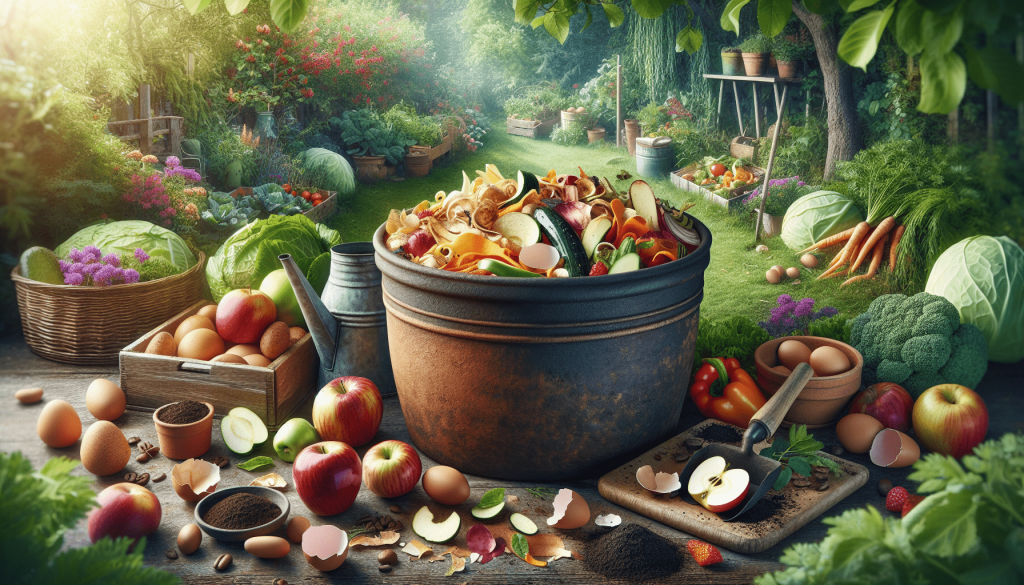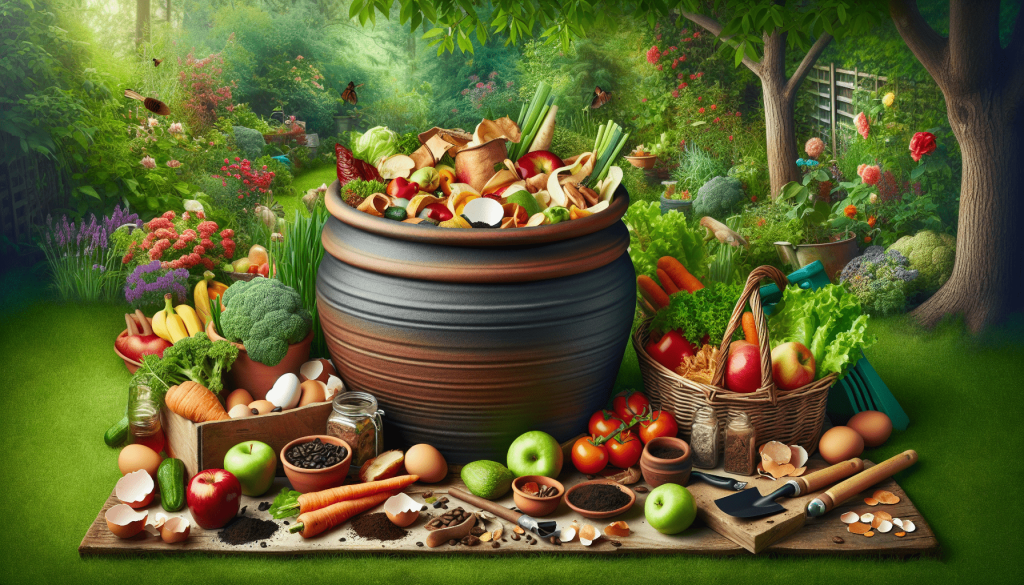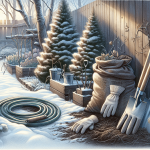This post may contain affiliate links. As an Amazon Associate, we may earn commissions from qualifying purchases.
Have you ever found yourself staring at a pile of kitchen waste and wondering what the best practices are for composting it? Let’s take a friendly stroll through the ins and outs of composting kitchen waste, so you can turn those food scraps into rich, fertile soil for your garden.
Why Compost Kitchen Waste?
Understanding the “why” before tackling the “how” is always a good start. Composting pays off in multiple ways. It reduces your kitchen waste, saves landfill space, and enriches your garden soil. Plus, it’s fun and satisfying to see your waste transform into something useful.
Environmental Benefits
Composting helps reduce the amount of organic waste dumped in landfills, which in turn reduces methane gas emissions—a potent greenhouse gas contributing to climate change. By diverting kitchen scraps from landfills, you play a part in reducing these emissions.
Soil Health
Compost enriches the soil, promoting healthy plant growth. It adds essential nutrients, improves soil structure, and increases its ability to retain water. Whether you have a small backyard garden or a few potted plants on your balcony, compost can make a significant difference in growth and yield.
What Can Be Composted?
Before diving into the nitty-gritty, let’s clarify what can and cannot go into your compost. This will save you a ton of headache down the road.
Green Materials
Green materials are rich in nitrogen and decompose quickly, providing essential nutrients. These include:
| Type of Green Material | Examples |
|---|---|
| Fruit Scraps | Apple cores, banana peels |
| Vegetable Scraps | Carrot tops, spinach stems |
| Coffee Grounds | Used coffee grounds, filters |
| Tea Bags | Paper-based tea bags |
| Eggshells | Crushed eggshells |
| Fresh Grass Clippings | Green, not dried out |
Brown Materials
Brown materials are rich in carbon and decompose more slowly. They provide structure, allowing air to circulate within your compost. Examples include:
| Type of Brown Material | Examples |
|---|---|
| Dry Leaves | Fallen autumn leaves |
| Cardboard Pieces | Shredded cardboard |
| Paper | Unprinted paper |
| Straw or Hay | Non-green straw/hay |
| Wood Chips | Small, untreated chips |
What Not To Compost
Not everything decomposes safely or efficiently. Beware of these items:
| Do Not Compost | Examples |
|---|---|
| Meat and Fish | Bones, scraps |
| Dairy Products | Milk, cheese |
| Oily Foods | Salad dressings, cooking oil |
| Synthetic Materials | Plastic, glass |
| Diseased Plants | Infected foliage |
| Pet Waste | Feces from cats, dogs |

Setting Up Your Compost Bin
Setting up your compost bin correctly is crucial for optimal decomposition and odor management. Trust me, you’ll want to get this part right.
Selecting the Right Bin
Whether you opt for a simple DIY setup or a fancy commercial bin, consider these factors:
| Feature | DIY Compost Bin | Commercial Compost Bin |
|---|---|---|
| Cost | Generally cheaper | Can be more expensive |
| Customization | Fully customizable | Limited to design specs |
| Ease of Use | May require more maintenance | Often designed for convenience |
Location
Place your compost bin in a well-drained, shaded spot. Ensure it’s accessible yet not in direct view—ideally within easy walking distance from your kitchen, but not where guests will stumble upon it.
Aeration and Moisture
Aeration and moisture levels are critical. Too little air, it turns slimy and stinky. Too dry, it stagnates. A good rule of thumb is to mix and turn your compost at least once a week to keep things well-aerated. Aim for a moisture level similar to a wrung-out sponge.
The Composting Process
Understanding the composting process helps you better manage your bin and produce high-quality compost.
Layering
Layering your compost can significantly affect its efficiency. Start with a layer of coarse materials like wood chips or straw for aeration at the bottom. Then alternate between green and brown layers.
Turning the Pile
Turning your compost helps speed up decomposition by providing oxygen to the microorganisms breaking down the organic matter. Use a garden fork or a specialized compost aerator to turn the pile weekly.
The Decomposition Timeline
Depending on what you compost and how well you manage your bin, the decomposition process can take anywhere from 2 months to a year. Regularly adding fresh materials and turning your compost pile can speed this up.

Common Problems and Solutions
Just like any worthwhile endeavor, composting comes with its challenges. Don’t worry, we’ve got some friendly advice to get you through the rough patches.
Odor Issues
Unpleasant odors arise when the balance between green and brown materials is off or if the pile is too wet. To fix this, mix in more brown materials like dry leaves or shredded paper.
Pest Problems
Uninvited guests like rodents or insects can be an issue. Avoid composting meats and dairy products that attract pests. Ensure your compost bin is sealed and has no easy entry points for critters.
Slow Decomposition
If your compost seems dormant, it might be too dry or lack nitrogen. Add more green materials like vegetable scraps and water it lightly. Turn it more frequently to revitalize the process.
Harvesting Your Compost
Knowing when and how to harvest your compost is crucial for getting the most out of your efforts.
When is it Ready?
Your compost is ready when it’s dark, crumbly, and emits an earthy smell. The original materials should be indistinguishable.
How to Use Your Compost
There are various ways to use your finished compost:
| Method | Application |
|---|---|
| Soil Amendment | Mix into garden soil |
| Mulch | Spread around plants |
| Potting Mix | Blend with other potting materials |
Composting Variations
If traditional composting isn’t your thing, there are several alternatives you can try.
Vermicomposting
This involves using worms to break down organic matter. It’s ideal for small spaces and can even be done indoors.
| Feature | Vermicomposting |
|---|---|
| Space Requirement | Minimal |
| Maintenance | Low, worms do most work |
| Output | Vermicompost or worm castings |
Bokashi Composting
Bokashi uses a special fermentation process to break down food waste. Unlike traditional composting, it can handle meat and dairy.
| Feature | Bokashi Composting |
|---|---|
| Space Requirement | Varied, can be done indoors |
| Maintenance | Moderate, requires special bran |
| Output | Pre-compost |
Final Thoughts
By now, you’ve got a handle on the best practices for composting kitchen waste. Implementing these tips will not only reduce your household waste but also enrich your garden, keeping you in harmony with the environment. Enjoy turning those kitchen scraps into garden gold!
You’ll find that composting is not just an eco-friendly habit but also a rewarding one, making you feel a little more connected to the cycle of life. So grab your kitchen scraps, start that compost bin, and let nature do its thing.








